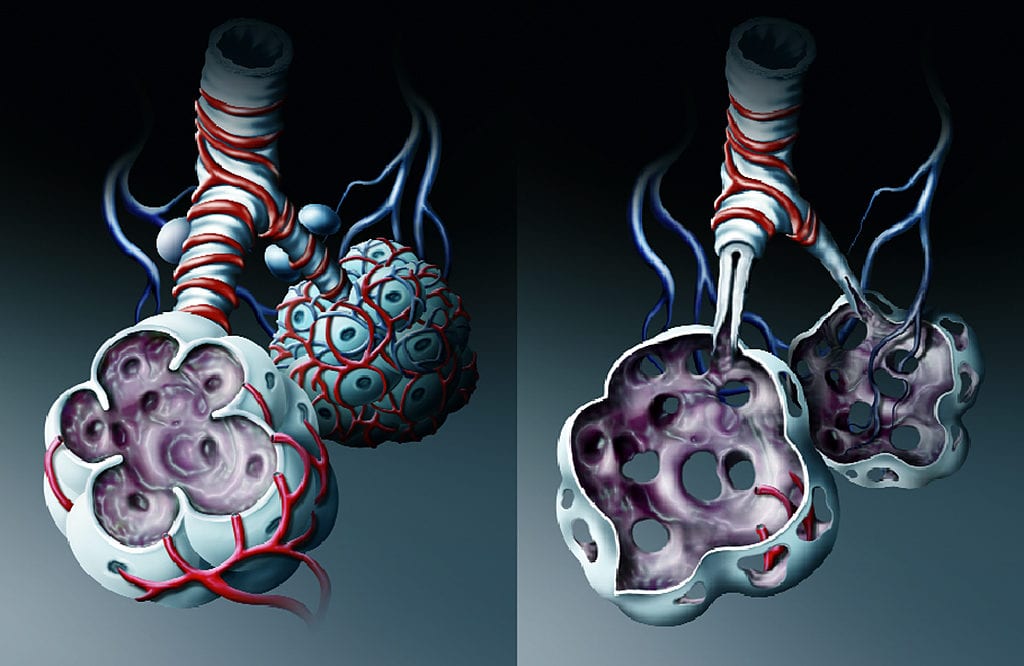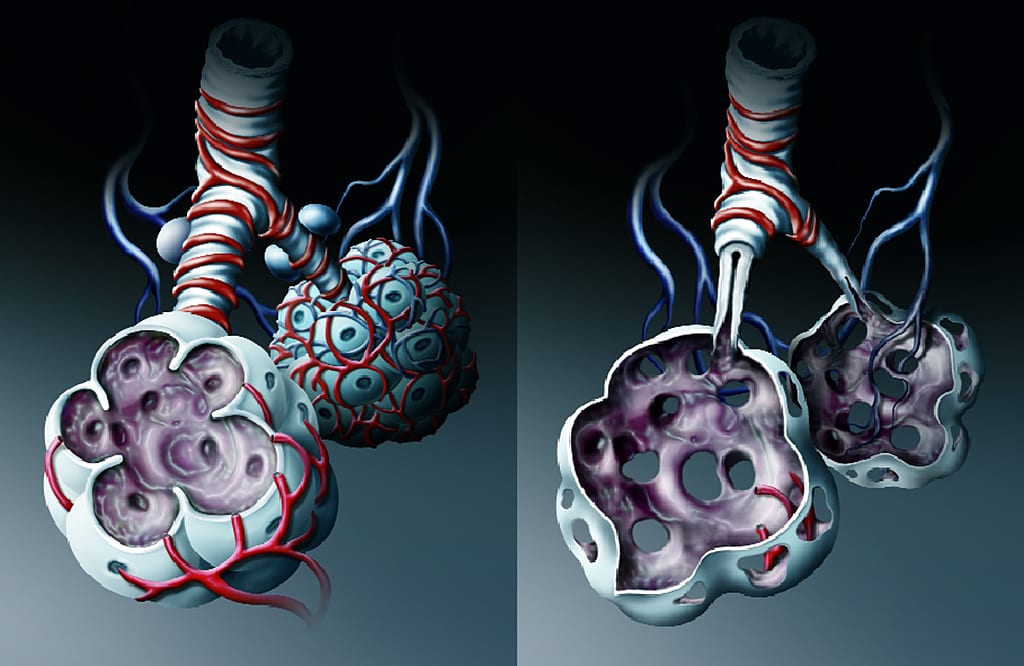
Chronic obstructive pulmonary disease, COPD is a progressive lung disease with emphysema and chronic bronchitis being the common one. In fact, stats indicate that there are over 250 million people in the world that are affected by COPD with over 65 million are from moderate to severe ones.
Emphysema:
Damage to the air sacs (alveoli) causes emphysema. In this, the walls inside the alveoli vanish, thereby expanding the small sacs. Since the bigger sacs don’t absorb much oxygen, there’s less oxygen absorbed into the blood vessels.
In fact, when the alveoli damages, the lungs expand, stretch-out, and lose their elasticity. Due to this, the air gets trapped in the lungs, airways become flabby, and you will feel difficulty in breathing.
Chronic Bronchitis:
In this condition, the bronchial tubes get damaged and cause chronic bronchitis. This occurs when the bronchial tubes are swollen and irritated. The problem starts with coughing and shortness of breath. This means, if the mucus comes up with the cough and cold, and last at least three months or more, the condition has become chronic.
Furthermore, there are hairlike fibers called cilia, that are lining the bronchial tubes of the lungs. The cilia help to move the mucus up in the tube so that it can be coughed out easily. In chronic bronchitis, the tubes have lost their cilia, making it hard to cough the mucus. This makes coughing, difficult and irritated.
While there’s no such treatment for the COPD, the treatment help easing the symptoms by minimizing the chance of complication. However, untreated COPD leads to faster progression of the disease, heart problems, and can hamper the respiratory infections.
Symptoms Of COPD:
COPD causes breathing issues, and if chronic, you might find yourself using the Invacare perfecto2 oxygen concentrator to get enough supply of oxygen. You might experience tightness in the chest, wheezing or might have excess sputum production.
Also, you might have acute exacerbations, which are flare-ups of the chronic symptoms. There will be mild symptoms at the initial stage; some of them include:
- Shortness in a breath, especially after doing some exercise and physical activity
- Having the feeling to clear the throat
- Mild and recurrent cough
- As lungs become more damaged, you might experience issues like:
- Chest tightness
- Chronic cough, with or without mucus
- Higher pitched noisy breathing or wheezing effects
- Frequent colds and cough
- Lack of energy
- Fatigue
- Swelling in legs, feet, and ankles
- Weight loss
Is All COPD Same?
COPD is of different types, with each one depending on the symptoms you feel every day and how well the treatment works. Health conditions like heart disease, depression, diabetes, heartburn, and high blood pressure also affect the COPD and make the situation worse. Here are a few conditions that help in determining the type of COPD you are suffering:
- Enough cough? Do you also cough up mucus and there’s no stopping of this situation? You have chronic bronchitis type of COPD, which will respond to the different medicines.
- Are your lungs feeling stretched out and are larger than the normal size? This might be more of an emphysema kind of COPD.
Copd Diagnosis:
While there’s no single test, especially for the COPD, diagnosis and treatment rely on physical exam and diagnostic test results. This means, whenever you visit your doctor, tell them:
- If you are an avid smoker or you have smoked in the past
- You have lung irritations
- You are more into secondhand smoking
- You have a pedigree of COPD
- You are suffering from asthma or any other respiratory disease
- You take any other prescription medicine
Treatment Of The Disease:
Treatments of the COPD can ease the symptoms and can prevent you from complications. Some of the common treatments include:
Offering Medication To The Patient:
Medicines like Bronchodilators help relax muscles and to ease the widening of airways so that you can breathe easily. You can have this medicine through an inhaler or through a nebulizer.
Supplemental Oxygen :
If you have too low blood oxygen level, you will get supplemental oxygen by using a mask or the nasal cannula to ease-out the breathing process. There are portable units and concentrators available to make it easy for you to get oxygen.
Adopting A Healthy Lifestyle:
Certain changes in daily habits and lifestyle can provide relief to the disease. For instance:
- If you are a smoker, try to reduce/quit it.
- Get the desired nutrition or work with the dietician to get a healthy diet plan
- Know how much exercising is safe for you.
So, now that you know the condition, causes, and treatments of COPD, be prepared for the flare-ups. Carry emergency tools and stay protected.
